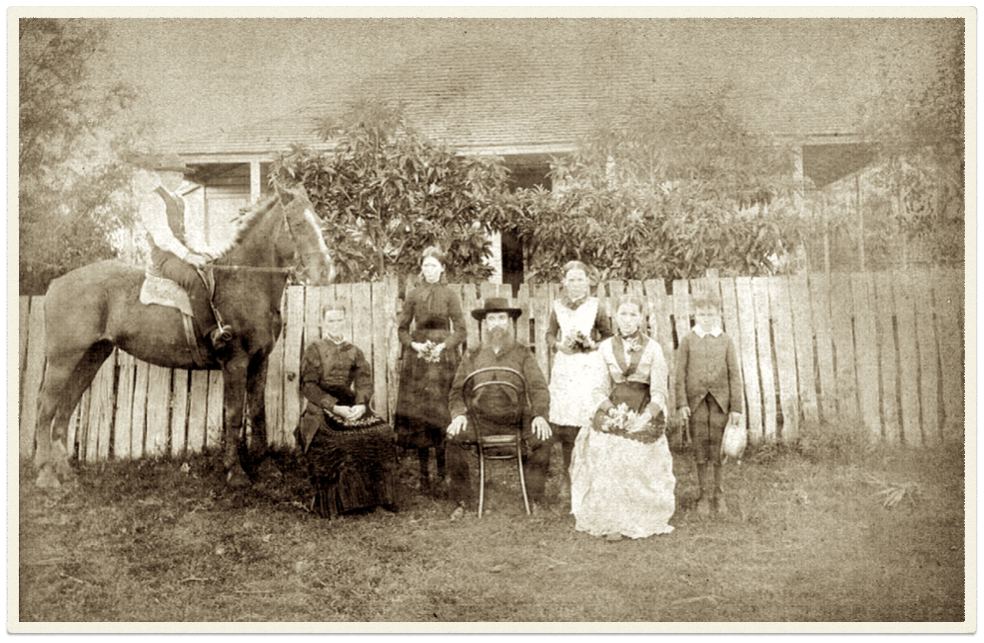
This photo of the Moran family was taken in 1889 outside of their home in Railway St, Rosewood.
L-R: Patrick on the horse, Mary, Ellen, James (snr), Catherine, Julia, James (jnr).
Rosewood History
James MORAN and Mary O’BRIEN
First and foremost I would like to thank Greg Brown and Mary Brown Parsons, great grandchildren of pioneers James and Mary Moran, for their generous assistance with photos and information.
Name: James MORAN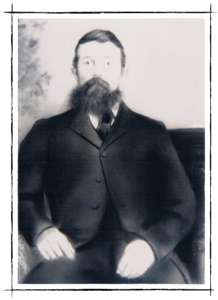
Occupation: Farmer
Birth: 1834, Shragh, Woodford, Co Galway, Ireland
Baptised: 3 January 1834, Woodford, County of Galway, Diocese of Clonfert, Galway, Ireland
Immigration: 21st April 1856, the Maitland arrived Sydney, New South Wales.
Residence: 45 Railway Street, Rosewood, Queensland
Death: 22nd July 1896, at the Rosewood Hotel, John Street, Rosewood, Queensland aged 62 years
Burial: 24th July 1896, Ipswich Cemetery
Religion: Roman Catholic (Roman Catholic B, Grave number 5753)
Father: Patrick MORAN
Mother: Julia/Judith HICKEY
Marriage: 1860, Wollongong, New South Wales (RN 285; Roman Catholic Illawarra; Wollongong)
Spouse: Mary O’BRIEN
Birth: about 1836, St Johns, Kilkenny, County Kilkenny, Ireland
Immigration: 17th February 1848, the Sir Edward Parry arrived Sydney, New South Wales.
Land Purchase: 20th August 1867, Portion 16 consisting of 80 acres Parish of Walloon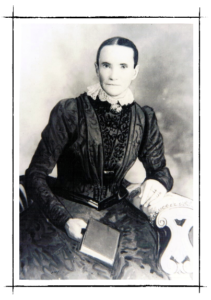
Residence: 45 Railway Street, Rosewood, Queensland
Death: 25th October 1916, Rosewood, Queensland aged ca.79 years
Burial: 26th October 1916, Ipswich Cemetery (Roman Catholic B)
Religion: Roman Catholic
Father: Laurence O’BRIEN
Mother: Catherine BURKE
Children: 6
Julia Ann MORAN (1867-1957) = Michael DREW
Mary MORAN (1870-1871)
Patrick Francis MORAN (1872-1945) = 1. Catherine HACKETT 2. Ada Kathleen LARNER
Ellen MORAN (1874-1895) = Alfred Patrick HERBERT
Catherine MORAN (1876-1966) = John BROWN
James MORAN (1879-1954) = Alice O’DONOHUE
James Moran left his parents and his home in Sragh, Ballinakill and boarded the Maitland, under the charge of Captain Lamond. She sailed from Southampton on the 16th December 1855 with 298 immigrants and arrived at Botany Bay in May 1856. The passenger manifest says that James Moran, aged 16, had no relatives in the Colony and his passage (£5) had been paid for by Thomas Moran from Wollongong. James Moran was literate, he could read and write and he had never been in service.
As a matter of interest, there was a Thomas Moran, a farm labourer aged 21, travelling with James. Thomas had a sister named Mary in Sydney. His parents were William and Mary (deceased). Like James, Thomas came from Ballinakill.
Additionally, James Moran’s sister Ann Moran aged 18, was also sponsored (£5) by Thomas Moran. She arrived on the Monica in 1857. The records state her parents were still living near Woodford and she had a brother named James living in Sydney. Ann married Thomas McKew. They lived in the Gatehouse at Rosewood for some time before moving to Forest Hill.
Back to James….
Sea captains could be treacherous and people migrating had more than just a new life to deal with. I wonder if James witnessed the abuse that some of the sailors accused their captain of perpetrating upon them during the voyage?
In May 1856, Captain Joshua Lamond was brought before the Water Police Magistrate charged with attempting to kill a seaman named George Ramsay. He tried to shake him off the main topgallant mast while he and three other men were stowing the sails. Then he attempted to shove him overboard. Lamond was committed for trial and released on bail. After hearing evidence from the ship’s surgeon and other ships’ captains Cowe, Webb, and Spront, who testified as to the impossibility of shaking men off the yard, he was found not guilty and discharged. More seamen alleged abuse and ill treatment and took him to court with slightly more success.
Two of the write-ups about that can be found here. CHARGE OF MURDER UPON THE HIGH SEAS WATER POLICE COURT
Now to Mary….
Mary O’Brien’s parents were Bounty Immigrants, who immigrated to Sydney in 1841 on the Moffat with their two year old son David. Their other children remained in St Johns, Kilkenny, Ireland. Bounty immigrants were free immigrants whose passage was paid by the colonial government under the ‘bounty scheme’. It was a scheme where an incentive was paid to recruiting agents in Britain to find suitable skilled labour for the new colony. Bounties were paid to the ships’ masters for the safe delivery of their passengers under the scheme. The typical bounty was £19 ($38) for an adult and £5 for a child.
Six years later, in 1848, Mary O’Brien (“Bryan” on the manifest) aged 11, her sister Rose aged 13 and brother Patrick (a Shepherd) aged 15, came to Australia. They came under the Immigration Government Notice of 26th May 1846 (below).
Colonial Secretary’s Office, Sydney, 26th May 1846
Whereas under the system of Bounty Emigration which continued in operation until the end of the year 1841, many married couples are represented to have emigrated to this Colony without their children, in consequence of their inability to pay the sums demanded, in addition to the Government Bounties, for the passages of such children; and whereas it has been deemed expedient to afford to such children, out of the Public Funds, the means of rejoining their parents. Notice is hereby given, that application for free passages for his or her children will be received from any Bounty Immigrant who left Great Britain on or before the 7th day of January 1842, provided that such Immigrant was produced before, and passed by, the Immigration Board either at Sydney or Melbourne, as one of a married couple.
The children’s parents applied to the Agent for Immigration at Sydney for their passages to Sydney. They had to provide the Agent with a promissory note for £5 for each child and two guarantors as security that the children would be picked up from the depot very soon after their arrival.
Other conditions applied:
1. That on their arrival in the colony, the children be severally produced before the Immigration Board in good bodily and mental health.
2. That every male under the age of fourteen years, and every female, be shown to the satisfaction of the Immigration Board to have been under the charge of a married couple during the voyage.
3. That every male above eighteen, and every female above fifteen years, be provided with testimonials of good character, signed by clergymen and respectable inhabitants of note in the places of their former residence.
4. All persons to whom passages are granted by the Government, are required to provide themselves with a sufficient supply of clothing, &c, for the voyage.
Mary, Rose and Patrick boarded the Sir Edward Parry at Plymouth on the 5th October 1847 and arrived at Port Phillip, Victoria on 24th January 1848 along with other juvenile immigrants. There were 76 in total as well as 94 adults. The three children were among those who stayed on board to sail for Sydney, arriving on 3rd February. The manifest shows they could all read and write.
Just like James Moran’s voyage there was trouble on this voyage too. Captain Freeman charged 10 of the seamen on board with revolt in the Sydney Water Police Court on 28th February 1848.
Mary, Rose and Patrick joined their parents at Wollongong, which is also where James Moran went after his arrival. No doubt James met Mary there.
After their marriage James and Mary travelled from New South Wales to Bigge’s Camp, Queensland. It is possible they went there because they knew John Moran, owner of the Jockey Club Inn at Bigge’s Camp. John had lived in Sydney before buying the Jockey Club Inn in 1857. (More research required)
In 1867 Mary Moran bought 80 acres of land in what is now Railway Street, Rosewood. James and Mary grew maize and farmed dairy cattle on this land. They were among the first residents at Rosewood Gate.

There are numerous reports of the men in the township who liked to have a “few too many” and just like nowadays, it got them into strife sometimes.
In the Queensland Times, on the 24th October 1868, this article appeared.
A report was brought into Goodna on Wednesday evening, that a man was lying dead in the middle of the road near to Oxley. The sergeant of police rode off to ascertain the truth of the report, but found, on examination, thatthe man was only dead drunk. He was conveyed to the lock-up, and fined five shillings next morning. The prisoner, who called him self James Moran, stated that he was a resident at Rosewood and had been confined in Brisbane Gaol for two months on a conviction of sly grog selling. (Interestingly, I can’t find a report about him going before a magistrate and being sentenced for this crime.)
James Moran was appointed to a committee formed at a public meeting called by John Vance in September 1870. The meeting was held for the establishment of a primary school at Rosewood Gate. The school opened in 1875.
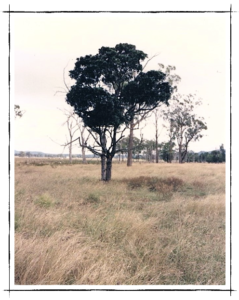 In 1871 there was a shattering event. James and Mary became bereaved parents when their infant daughter Mary died 3 days before her first birthday.
In 1871 there was a shattering event. James and Mary became bereaved parents when their infant daughter Mary died 3 days before her first birthday.
Until Greg Brown sent me the photo at left, I hadn’t really considered what happened if a child died in those very early days before a local burial ground was established in 1876. It was touching to read Greg’s words which accompanied the photo he provided.
The interesting part is that Mary is buried on the Rosewood property. I do not imagine there is any evidence of her grave there today but it was down towards Moran’s Bridge inside the property about 50-100 metres. The grave originally was marked with iron railings and with two trees, a Rose Apple and a Cypress tree, but with time and floods I think most of these have disappeared. Attached is photo of the Rose Apple tree still existing in the 1960’s.
The first Mass in what is now Rosewood was celebrated in the house of James and Mary Moran by Father Brun in 1872. Some time after the Rising Sun Hotel opened in 1874, the service was moved there, until a church was built in 1885.
I believe the practice of home mass was shared around and mass celebrated in various places. I still remember the chiffonier that was used for the altar, it used to be stored in the barn on the farm until Dad decided to clean it up and sell it. Piece of history. Also glass candle sticks used, I think, held by a family member.
Also of interest is that the altars in St Brigid’s church have name plates attached which are in memory of James and Mary and were donated by family members. – Greg Brown
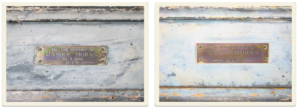
This snippet was taken from the Rosewood Register and Marburg Mail. It is extracted from an article called “Rosewood Pioneering Reminiscences” by Kola Knut.
The average reader would be inclined to think that only the strongest men would be successful as pioneers. Rosewood experiences prove the contrary. Messrs Moran, Dutney, Bunny, Mitchell, Vance, and many others, were men of small physique and indifferent health, who from this cause, were obliged to employ labour to fence and clear their farms. Their disabilities did not prevent them from attending to their crops, the marketing of which at the proper time was an important feature of their success. Other factors were the excellent quality of their land and the hope that the farms would be their own by Deed of Grant.
I had that snippet in mind when I found a report of indigenous people working for the early settlers, and it included James Moran. Previously I’d read about a group of aboriginals who visited Rosewood Gate in October 1881 and performed a corroboree, but I hadn’t yet found earlier information. The 1931 report came from an old resident of Rosewood who was the son of other pioneers. James Scanlan MB spoke of his recollections of an incident that happened in the very early days of the town. He said that James Ryan, in addition to conducting hotel and butchering businesses, owned a farm on which there was a record crop of maize. Prices for the grain were very low, so Ryan engaged about twenty aboriginal men, women and children to pick, cart, and bag his corn ready for market. James Moran also had maize to harvest. He asked an aboriginal woman (who was looking for work on behalf of herself and others) about the conditions they would work under and how much pay they usually received. The woman told him what James Ryan (or “Jim” as she referred to him) had paid. James Moran told her to get her tribe together and they could start on his work on the following Monday. The woman explained that she had to see Mr. Tomkins first. James asked “Who is Mr. Tomkins?” She replied, “Everybody know Mr. Tomkins; dat fellow my husband.” (1)
James Moran was one of the founding members of the Rosewood Farmer’s Club. He won first prize for his butter at the Club’s first show in 1878 and many more prizes followed over the years. Butter was well represented, there being no fewer than thirteen exhibits; the whole of them with one or two exceptions, were of excellent quality, and had been most tastefully prepared. The judges found it no easy matter to decide which was deserving of first honours. After, however, very carefully sampling the various exhibits, they awarded first prize to James Moran, and second to Samuel Waight. (2)
Mary also won two shillings at the show in 1883. She won 3rd prize for the “best 6lb of candles made by a farmer’s wife”.
James Moran summoned John Madden to a hearing before the Police Magistrate in Ipswich on 28th August 1882. He accused John Madden of assaulting him.
Mr. Chubb appeared for the complainant. The defendant pleaded “Not guilty.” The complainant, a farmer residing at the Rosewood, deposed that when returning home from Ipswich the 22nd instant, he saw the defendant, who said, “What have you been saying about me!” following up the question by striking him with his fist on the head, breaking his (witness’s) cabbage-tree hat: the latter fell from the effects of the blow; on getting up, the defendant again struck him, the result being that he was again knocked down and became insensible; witness had had occasion for summoning the defendant before for assaulting him.
Dr. H. M. Lightoller, to whom the complainant went on the 24th instant, described the nature of the injuries which the latter had sustained.
In answer to the defendant, the complainant stated that a prohibition had been obtained to prevent him from being served with drink; and some of the witnesses who were examined in the case stated that the complainant appeared to be under the influence of liquor.
The persons examined were-Henry Jefferies (railway station-master), Mark Bensley, Thomas Green, and Bernard Sloan; and, after hearing their testimony, the Bench dismissed the case, and ordered complaint to pay £1 10s. 8d. costs. (3)
Another article of a different kind was published on page 5 of the the Queensland Times on Saturday, 13th September 1884.
On Thursday afternoon last, an interesting trial of an American ‘Sulky’ plough took place on the farm of Mr. James Moran, at Rosewood. There was a good attendance of farmers, who watched the working and examined the construction of the plough with considerable interest. The machine was exhibited by Mr. A. Campbell, agent for Mr. William Fleming, the ‘American Agricultural Machinery Merchant,’ of Sydney. One of the chief improvements claimed for this plough is the ease with which it can be worked. It is mounted on a light carriage, and the driver is provided with a seat in front. By moving a lever, which is fixed close to the hand, he can raise or lower the plough, according to the nature of the work required to be done. The construction of the machine is not at all complicated, and, consequently it is readily managed, and not liable to be damaged if handled with ordinary care. Three horses were attached to the plough, and it is claimed that, with them, three and a half acres a day can easily be turned over. It will plough ten to twelve inches deep, and throw a slice sixteen inches in width. All the spectators were highly delighted with the plough and with the work done by it. They were particularly struck with the complete manner in which the slice was inverted and with the way in which all weeds, cornstalks, &c., were cut down and buried. They determined that, with this plough in operation, the weeds, which grow so profusely in the scrub, will no more be the abomination they have hitherto been, but rather the reverse, as they are easily and completely buried, and, when buried, will enrich and lighten the soil. Mr. Boughen was so pleased with the performance of the plough that he at once gave an order for one. I would advise all farmers who have the opportunity to examine the machine and see it working. Its price is £16, and it is undoubtedly what it professes to be – i.e., easy to work, simple, cheap, and effective.
In July 1886 James was the delegate for Rosewood at the Home Rule Meeting held at St Mary’s new Roman Catholic School in Ipswich. The Irish people wanted their own parliament and so meetings were held nationally by Irish folk who supported the idea. HOME RULE MEETING
Greg Brown provided another clipping from “Rosewood Pioneering Reminiscences” by Kola Knut dated Friday, 3rd June 1927. This is an extract.
Mr James Moran was also a prominent dairyman, his herd having easy access to the reserve and the lagoon, near the dip yard, which was then a fairly large and deep stretch of water. It was considered of so much importance to Rosewood as a water supply that an attempt was made by Mr Vance and others to secure Goverument assistance in having it fenced and cleaned out, but without avail. Two bores were drilled previously with the object of a water supply for the town-one near Mr Elder’s shop, and the other at the corner of Mr J Arndt’s farm-but only mineral water was struck, quite useless for a town supply. Mr Moran had a ready market at good prices amongst the neighbouring settlers for all the heifer calves he coud rear and the advantageous situation of his farm made this side line very profitable. Although a thin delicate man, as frequently happens, Mr. Moran had a cheerful manner, and was a master hand at a joke. About Eastertide, he met Mr R. Mason senr., who asked if he had any heifer calves for sale. Yes, he had plenty of them in the back paddock amongst the rushes, for which he (Mr Moran) would take a very low price. “Come up in the morning, and if they suit you we can make a deal.” Mr Mason turned up before Mr Moran commenced milking. After waiting at the yard until the milking was finished, they went to the paddock with the rushes, where a large flock of wallabies were hiding, but no heifers. Mr Mason became very angry, asking what was meant, and Mr Moran ran away, reminding his neighbour of the date -“lst of April.”
James died suddenly in 1896. He died in a building erected by my great grandfather in 1879, the original Rosewood Hotel.
Quite a gloom was cast over the township of Rosewood, on Thursday last, when it became known that Mr. James Moran, an old and much respected resident of that district, had died suddenly on the previous evening. It seems that Mr. Moran, who lived in the township, felt particularly cold on Wednesday last (which was a bitterly cold day), and early in the evening he announced his intention of taking a walk to the house of a friend. While on his way thither, he entered Mr. Robert Hodge’s hotel, where he sat down to rest, and seemed to have fallen asleep, but when the landlord tried to arouse him he found that he was dead, he having expired in a sitting position with his hands to his head. Mr. Hodge at once reported the matter to the police, who took charge of the body. A post-mortem examination was subsequently held, which revealed the fact that death had resulted from heart disease. The deceased, who was sixty years of age, leaves a widow and grown-up family (some of the members of which are married), and general sympathy is expressed for them in their bereavement. He was a prominent member of the Roman Catholic Church, taking a lively interest in all matters connected therewith. The funeral took place yesterday afternoon at the Ipswich cemetery, when a large concourse of people followed the remains to their last resting place. Mr. Moran was one of the early pioneers of West Moreton, and was one of those who worked hard for the advancement of its agricultural interests. (4)
After James died, Mary battled with the council during the years when the town’s drainage scheme was being initiated and installed. The council, which had engaged an engineer to design the scheme, was trying to get a loan from Treasury for it. In 1911 Mary engaged Cardew and Simpson, solicitors, to represent her in her fight to stop the water from being diverted to her land. She put the council on notice that she strongly objected to their proposal and was not prepared to consent to it. Furthermore, if the council diverted any water or drainage onto her land, she would hold it responsible for any damage she might suffer. The Chairman of the council, Cr Yates and the overseer P. A. Adams, went to see Mary to ask her if she would withdraw her objection. There was discussion about resuming part of her land as a solution. The Local Authorities Association advised that council could go ahead, but would have to pay Mary Moran compensation for any damage. The engineer for the scheme then sought advice from Brisbane solicitors. The solicitors were of the opinion that an owner of land was not entitled to claim compensation for damage they thought would be done to their property by one part of a drainage scheme, without making allowance for the general benefit of the work. They believed, in this instance, that the benefits more than outweighed any of the disadvantages. They were, therefore, of the opinion that the engineer was fully justified in recommending the fulfilment of the scheme to the local authority. Mary was unsuccessful in her battle.

The blue lines on the 1st map show the natural watercourse. The shorter line shows part of the original path the water took before the town’s drainage scheme was built. I have read that there was a small creek behind what is now Drakes IGA. The scheme for the town drain channelled the water further down John Street to Akes’ Plumbing which was down towards the police precinct. Like Mary, Demas Akes fought the Council to stop the planned section of drain running through his property to the gully in Mary Moran’s land.
Mary had a large circle of friends and was known for her kind and charitable disposition. She could tell many stirring stories of the pioneering days when she arrived at a dense scrub, and stories about the progress of Rosewood.
After living in Rosewood for forty-nine years, twenty of those without James, Mary died at her home. She had been in failing health for some years and was attended by Dr. Wallace in the weeks before her death. Fathers Keleher, Lane, and Casey, also visited and administered to her the last rites of the Church. Mary had been a devoted and faithful parishioner. The bell of St Brigid’s Church was tolled as the funeral cortege left her residence. She was buried beside her husband in the Ipswich Cemetery, the Rev. Father Casey officiating at the graveside service.
Mary left a family of five: Messrs. Patrick (Cabramatta, N.S.W.), James (Rosewood), Mesdames P. Drew (Ipswich), Herbert (N.S.W.) and J. Brown (Rosewood). She had 20 grandchildren. At the time of her death Mary’s sister, Catherine O’Brien, was living at Glebe Point in Sydney. Her sister Rose married Dennis O’Neill in 1854 and died at Bemboka in 1915. There were other siblings, an older brother Patrick and younger siblings David, John, William and Ellen who predeceased Mary.
The Moran’s family home underwent some changes over the years. Greg and Mary shared some photos of the old house before and after renovations were carried out in 1956. You can see them here.
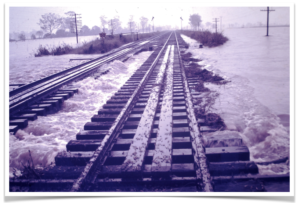
The railway bridge nearby to the Moran’s home became known as Moran’s Bridge. In those early days it was the only means of crossing the railway line when the gates were closed. The above photo is of Moran’s Bridge in flood.
Moran’s name is remembered by the name of the first bridge on the railway line going towards Toowoomba. Legend has it that the trains in the early days stopped opposite Moran’s house to let down and pick up passengers. A descendant of the Moran’s, Mr. Jack Brown, still lives in the same house as his grandparents.(5)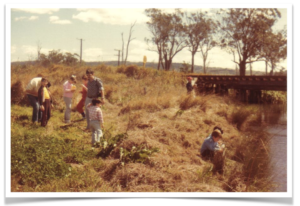
There always has been as long as I can remember, a water hole under the bridge and it was a good fishing spot for catfish, perch and eel, especially after a flood. Under the bridge on both ends there was room to cross under bridge to access the other side. I rode a horse, or rather led my horse through there many a time when taking the cattle from our place to the local tick dip located on banks of Western creek and then returning again after dipping the cattle. I was only about 10-11 at the time and was accompanied by a great gentleman and horseman Mr Walter Dale, who lived next to Bloxidge’s residence in William St. Walter was the father of Mrs Pearl Bloxidge. What makes Moran’s bridge an interesting place is it was a favourite place for swaggies to regularly camp back in the late 40’s/early 50’s. We could see the smoke from their campfire from our place and were always warned by our parents never to go down there while a swaggie was camped there. Great history and many ghosts around that bridge. Not sure if any swaggies actually died there but is a possibility. – Greg Brown
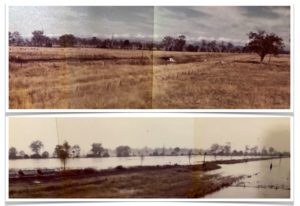

In the 1950’s many residents of Rosewood referred to the land behind the Moran’s house as “Brown’s paddock”.
This is a picture of a patch of Rosewood Scrub which exists on the property settled by James and Mary. The scrub during my day was our playground at weekends. We learned to eat native fruits which grew there and suck the gum of the briglow tree. I hope the patch is preserved to remind folk of what the early settlers faced when they ventured into the Rosewood area and had to clear the scrub to open up fertile agricultural land. – Greg Brown
Sources:
(1) Queensland Times, Friday 20 March 1931, page 6
(2) Queensland Times, Ipswich Herald and General Advertiser, Saturday 3 August 1878, page 3
(3) Queensland Times, Ipswich Herald and General Advertiser, Tuesday 29 August 1882, page 2
(4) Queensland Times, Ipswich Herald and General Advertiser, Saturday 25 July 1896, page 4
(5) Centenary of St. Brigid’s Catholic Church, Rosewood, Queensland – Brown, Geoffrey E. 1985
The personal collection and recollections of Greg Brown.
Ireland, Catholic Parish Registers, 1655-1915
Microfilm 02433/01 Page 50 Woodford; County of Galway; Diocese of Clonfert. Baptisms, Dec.1833 to Feb.1834
New South Wales, Australia 1828 – 1842: Bounty Immigrants List
New South Wales, Australia, Assisted Immigrant Passenger Lists, 1828-1896
New South Wales, Australia, Immigration Deposit Journals, 1853-1900
NSW Registry of Births, Deaths & Marriages
QLD Registry of Births, Deaths & Marriages

5 Comments
Well done Jane. A very interesting read. Thankyou for all your hard work in researching this family history.
Thanks Jane a great document for family to remember our ancestors.
Great to read .
This is amazing and so interesting
Very interested in the History of Rosewood my late husband was born in the St Kilda Hospital in Rosewood I have lived in Rosewood area from 1987. I also worked in two of the hotels in Rosewood